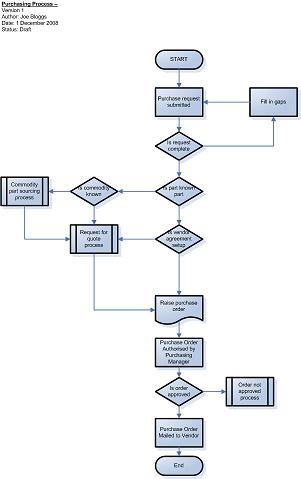In our previous article on How to produce a process map – capturing your business activity we reviewed how standard process maps are built from various icons and shapes placed in sequence to reflect physical steps in a business process.
In this article we’ll take a look at a simple example process map, taking what we learnt in our first article and putting it into practice – in this example we’ve used a simplified purchasing process, to illustrate how a process map can be constructed.
 Here’s our draft process (click the link get a larger version) – To begin with we’ve given the diagram a title (which refers to the process we’re mapping) – a creation date – an author, version number and status.
Here’s our draft process (click the link get a larger version) – To begin with we’ve given the diagram a title (which refers to the process we’re mapping) – a creation date – an author, version number and status.
As you can see we start of our diagram with a terminator shape that we’ve simply labled start – we’ve then used process boxes to indicate where processes take place.
Decision boxes have been used to represent where questions are then asked within the process – as you can see we’ve followed the route of the process based on whichever decision is made (in this case a yes or no).
Where the process leads to another documented process we’ve used the Predefined process shape to indicate this.
Where the process raises a document (in this case a purchase order) we’ve used the document shape
We’ve finished the process off with another terminator shape labeled End
Note that in this example we’ve used a basic flowchart – while this details the steps made within the process it doesn’t indicate how long each step takes or who carries out the task.
As you can see producing process maps isn’t too difficult – choosing the correct shapes to use and ensuring that you follow all the appropriate routes within the process might take a little practice. To get started – pick some work processes and practice tracing the process through and capturing it as a flow diagram.
In the next article we’ll take a look at the same process but in the context of a cross functional flowchart.